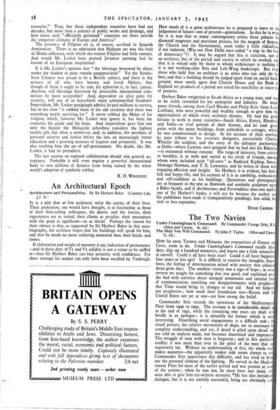An Architectural Epoch
Architecture and Personalities. By Sir Herbert Baker (Country Life. £2 2s )
IT is a pity that so few architects write the stories of their lives. Their profession, one would have thought, is as fascinating as those of their best-selling colleagues, the doctor and the lawyer, their experiences are as varied, their clients as peculiar, their encounters with the great as significant—or as trivial. Perhaps the reason for their silence is that, as suggested by Sir Herbert Baker in this auto- biography, the architect hopes that his buildings will speak for him, and that he needs no more enduring memorial than their bricks and stones.
If elaboration and weight of masonry is any indication of permanence —and in these days of VI and V2 solidity is not a virtue to be sniffed at—then Sir Herbert Baker can face posterity with confidence. For sheer tonnage his output can only have been excelled by Vanbrugh. How much of it is great architecture he is prepared to leave to the judgement of future—not of present—generations. In this he is wise, for it is true that to many contemporary critics these palaces for diamond magnates and merchant princes, for the moguls of finance, the Church and the Government, seem today a little ridiculous, if not indecent. (Was not New Delhi once called " a slap in the face of democracy "?) It may be argued that this is criticism, not of an architect, but of the period and society in which he worked, and that it is voiced only by those to whom architecture is nothing if it is not working-class flats and Left-Wing bookshops. But even those who hold that an architect is an artist who can only do his best, and that a building should be judged apart from its social back- ground, must surely agree that Church House and the Bank of England are products of a period not noted-for sensibility or sincerity of purpose.
Herbert Baker emigrated to Soith Africa as a young man, and was to be richly rewarded for his enterprise and industry. He made many friends, among them Cecil Rhodes and Philip Kerr (later.- Lord Lothian), who were powerful and wealthy enough to give him the opportunities of which every architect dreams. He had the good fortune to work in many countries—South Africa, Kenya, Rhodesia and India—at vital periods of their history, and he took great pains with the many buildings, from cathedrals to cottages, which he was commissioned to design. In his account of their erection he pays tribute to his associate designers, particularly Charles Wheeler the sculptor, and the story of the unhappy partnership at Delhi—where Lutyens once quipped that he had met his Bakerloo —is recounted without rancour. His range of interests, from cricket to heraldry, is as wide and varied as his circle of friends, among whom were included such " all-sorts " as Rudyard Kipling, Smuts, Montagu Norman, and T. E. Lawrence, and he writes of them with engaging affection and insight. Sir Herbert, it is evident, has had
full and happy life, and his account of it is as rambling, enthusiasn and self-confident as his buildings. Quotations and photograph
are as frequent in the text as flintwork and symbolic sculpture upo a Baker facade, and if Architecture and Personalities does not outlive one of Sir Herbert's banks, it will not be because the author any his publishers have math it (comparatively speaking), less solid, le rich or less expensive.
HUGH CASSON.


























 Previous page
Previous page